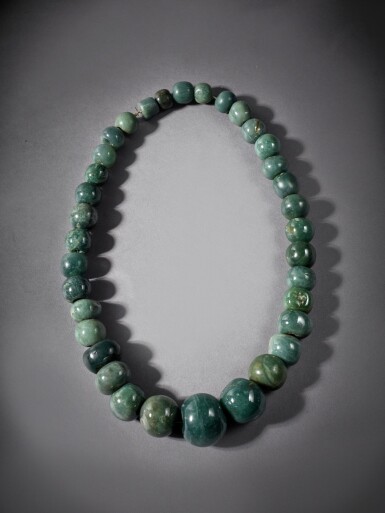Art of Africa, Oceania, and the Americas
Art of Africa, Oceania, and the Americas

Property from an American Private Collection
Olmec Jade Bead Necklace Middle Preclassic Period, circa 900 - 300 BC
Lot Closed
May 18, 07:45 PM GMT
Estimate
25,000 - 35,000 USD
Lot Details
Description
Property from an American Private Collection
Olmec Jade Bead Necklace
Middle Preclassic Period, circa 900 - 300 BC
Length overall: 32 in (81.3 cm), diameter of largest bead 1 1/2 in (3.8 cm)
Christie's, New York, November 12, 2004, lot 13, consigned by the above
American Private Collection, acquired after the above auction
Jade was the preeminent material in ancient Mesoamerica from Olmec through the Maya era, for conveying life-sustaining power and status. Known as chalchihuitl, jade represented the first green shoots of fresh growing maize, flowing water, and the promise of fertility and regeneration in this extremely durable and everlasting form. The Olmec preference was for blue-green jade shown on this suite of forty, slightly graduated hemispherical beads. The colors range from deep blue-green to seafoam blue, each with a lustrous polish.
Long jade bead necklaces were ostentatiously portrayed as an important part of any ceremonial or royal costume, as shown on limestone stela and as painted on polychrome vessels. Often the necklace beads flank a large jade or shell pendant and were also draped down the back of figures as counterweights.
For a similar bead necklace in the Dora and Paul Janssen collection, see Geneviève Le Fort, ed., Masters of the Americas: The Dora and Paul Janssen Collection, Milan, 2005, p. 108.
